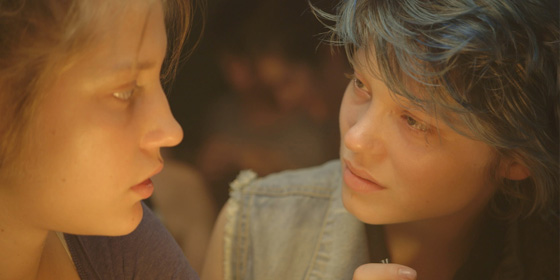The winner of this year’s Palme D’Or is a frank but absorbing study of a young girl’s sexual awakening.
Running close to three hours of screen time this is an epic of the heart and disarmingly in-depth depiction of falling in love.
When we first meet the protagonist, Adele (Adele Exarchopoulos) she is a 15-year old girl about to begin her first serious relationship with a classmate Thomas (Jeremie Laheurte).
However, a chance encounter with an older blue-haired woman named Emma (Lea Seydoux), leads her to question her emotions and feelings towards her own sex.
But this is just the beginning of the long journey which director Abdellatif Kechiche takes us on, as emotionally charged highs are gradually mixed in with heartbreaking lows.
Despite taking place over a number of years – I would roughly estimate around six – Kechiche cleverly uses the narrative, so key episodes gradually fade into another.
These segments could almost be short films in themselves: an early encounter at a lesbian bar; a tender scene in the park; and two awkward dinner parties are just some of the memorable scenes as Emma and Adele fall in love.
This is all depicted with remarkable authenticity, with the telling silences providing a neat counterpoint to the natural, flowing conversations.
The intensity of the film is heightened by the decision to mostly shoot in widescreen closeups, with cinematographer Sofian El Fani capturing the emotions and actions with piercing clarity.
Even in exterior environments, which are relatively rare in the film, the focus is on the characters, especially Adele.
This depiction intimacy spills over into the explicit sex scenes, which have attracted a lot of media attention since the premiere in Cannes.
In truth there isn’t a great deal to discuss other than the fact that they are more brightly lit and longer than most movie sex scenes.
The fact that three scenes has coloured discussion of this film for several months perhaps says more about certain journalists than it does about what is on screen.
Whilst the bravery of the two actresses should be noted, it as part of a much wider story, with many tones and textures.
Just as notable is the film’s embrace of the complexities of sexuality and human relationships, with both characters behaving in believably erratic and confused ways.
The themes of commitment, trust and social anxiety are all explored as the film progresses, and it says much about the skill of writer-director Kechiche that none of it ever descends into cliche or pat conclusions.
He is aided by two outstanding lead performances from Exarchopoulos and Seydoux, with the former taking the greater share of screen time.
Displaying a remarkable assurance in front of the camera, she not only has a natural screen presence but manages to convey emotion with the slightest of moves and expression.
Given that nature of how this film was shot – in searching, close-up compositions – it is a testament to their acting that the audience may feel like they’ve been in a relationship with the pair.
A rich, draining and highly accomplished drama.
Blue is the Warmest Colour screened at the London Film Festival on October 14 and 17th. (It opens in the UK on November 25th)
